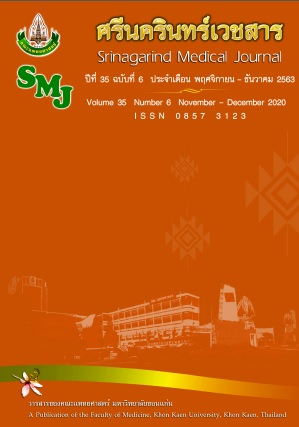Expression of Recombinant Peptide LcI from Bacillus amyloliquefaciens KKU14 and Test for Its Inhibition on Burkholderia pseudomallei
Keywords:
Antimicrobial peptide; Recombinant LcI peptide; Bacillus amyloliquefaciens; Burkholderia pseudomalleiAbstract
Background and objective: Burkholderia pseudomallei is a pathogenic bacterium, causing melioidosis, a serious infectious disease. Currently, the best treatment is using antibiotic drugs. However, many clinical strains are now intrinsically resistant to almost all available antibiotic drugs. Previous study indicated that Bacillus amyloliquefaciens KKU14 strongly inhibits B. pseudomallei. In this study, antimicrobial peptide LcI of B. amyloliquefaciens KKU14 was cloned and expressed to test activity against B. pseudomallei.
Materials and Methods: Antimicrobial peptide LcI was searched from GenPept database (NCBI) and amplified from genome of B. amyloliquefaciens KKU14 by PCR and cloned into different cloning vectors. The recombinant clones were induced and their activity against B. pseudomallei strain P37 were tested by agar well diffusion and in-gel overlay.
Results: The recombinant peptide was successfully cloned. However, the expression could be observed only in pQE31 vector. The expressed peptide has the size of approximately 10 kDa. Nevertheless, the recombinant clones exposed no antimicrobial activities against B. pseudomallei strain P37.
Conclusion: The recombinant peptide LcI cloned from B. amyloliquefaciens KKU14 does not inhibit B. pseudomallei strain P37 in this study. This might due to improper folding of the recombinant peptide, or the peptide that was responsible for inhibition of B. pseudomallei might be other peptides, or the inhibition effect might need synergistically work from several peptides together, which has to be further investigated.
References
2. Suputtamongkol Y, Hall AJ, Dance DA, Chaowagul W, Rajchanuvong A, Smith MD, et al. The epidemiology of melioidosis in Ubon Ratchatani, northeast Thailand. Int J Epidemiol 1994; 23(5): 1082-90.
3. Limmathurotsakul D, Wongratanacheewin S, Teerawattanasook N, Wongsuvan G, Chaisuksant S, Chetchotisakd P, et al. Increasing incidence of human melioidosis in Northeast Thailand. Am J Trop Med Hyg 2010; 82(6): 1113-7.
4. Wiersinga WJ, Currie BJ, Peacock SJ. Melioidosis. N Engl J Med 2012; 367(11): 1035-44.
5. White NJ, Dance DA, Chaowagul W, Wattanagoon Y, Wuthiekanun V, Pitakwatchara N. Halving of mortality of severe melioidosis by ceftazidime. Lancet 1989; 2(8665): 697-701.
6. Potisap C, Khan AW, Boonmee A, Rodrigues JLM, Wongratanacheewin S, Sermswan RW. Burkholderia pseudimallei-absent soil bacterial community results in secondary metabolites that kill this pathogen. AMB Express 2018; 8: 136. doi: 10.1186/s13568-018-0663-7.
7. Liu J, Pan N, Chen Z. Purification and characterization of an antibacterial protein from Bacillus subtilis. Acta Microbiol Sin 1993; 33: 268-273.
8. Liu J, Pan N, Chen Z. The characterization of anti-rice bacterial blight polypeptide LCI. Rice Genet Newsl 1990; 7: 151-4.
9. Gong W, Wang J, Chen Z, Xia B, Lu G. Solution structure of LCI, a novel antimicrobial peptide from Bacillus subtilis. Biochemistry 2011; 50(18): 3621-7.
10. Klaenhammer TR. Genetics of bacteriocins produced by lactic acid bacteria. FEMS Microbiol Rev 1993; 12(1-3): 39-85.
11. Froger A, Hall JE. Transformation of plasmid DNA into E. coli using the heat shock method. J Vis Exp 2007; 6: 253. doi: 10.3791/253.
12. Hames BD. Gel electrophoresis of proteins: A Practical Approach. 3rd ed: OUP Oxford; 1998.
13. Schagger H. Tricine-SDS-PAGE. Nat Protoc 2006; 1(1): 16-22.
14. Hu HQ, Li XS, He H. Characterization of an antimicrobial material from a newly isolated Bacillus amyloliquefaciens from mangrove for biocontrol of Capsicum bacterial wilt. Biol Control 2010; 54(3): 359-65.
15. Park WJ, You SH, Choi HA, Chu YJ, Kim GJ. Over-expression of recombinant proteins with N-terminal His-tag via subcellular uneven distribution in Escherichia coli. Acta Biochim Biophys Sin 2015; 47(7): 488-95.
16. Xu X, Jin F, Yu X, Ji S, Wang J, Cheng H, et al. Expression and purification of a recombinant antibacterial peptide, cecropin, from Escherichia coli. Protein Expr Purif 2007; 53(2): 293-301.
17. Xu Z, Zhong Z, Huang L, Peng L, Wang F, Cen P. High-level production of bioactive human beta-defensin-4 in Escherichia coli by soluble fusion expression. Appl Microbiol Biotechnol 2006; 72(3): 471-9.
18. Lai WS, Kan SC, Lin CC, Shieh CJ, Liu YC. Antibacterial peptide cecropinB2 production via various host and construct systems. Molecules 2016; 21(1): 103. doi: 10.3390/molecules21010103.
19. Ingham AB, Sproat KW, Tizard ML, Moore RJ. A versatile system for the expression of nonmodified bacteriocins in Escherichia coli. J Appl Microbiol 2005; 98(3): 676-83.
20. LaVallie ER, DiBlasio EA, Kovacic S, Grant KL, Schendel PF, McCoy JM. A thioredoxin gene fusion expression system that circumvents inclusion body formation in the E. coli cytoplasm. Biotechnology 1993; 11: 187-193.




